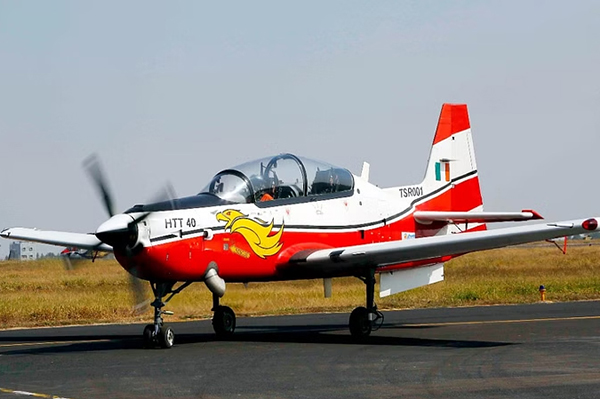The Indian Air Force (IAF), on 20 October, inked a Rs 6,800 crore deal with state-run Hindustan Aeronautics Limited (HAL) for the purchase of 70 Hindustan Turbo Trainer (HTT)-40 trainer aircraft, a move that reduces the pressure off the force which is juggling its training modules due to limited number of planes.
The HTT 40, a project that was funded by HAL through its own internal funds after the IAF had initially refused to take part, is now seen by the force as a game changer. The successful implementation of the project in record time is a big relief for the IAF.
The IAF pilots go through three stages of training using three different kinds of aircraft before they move on to fighters. The new aircraft will be part of the first stage of training for the IAF pilots – basic training – and will eventually replace the Swiss-made Pilatus aircraft bought in 2012.
The all-metal aircraft, which is powered by Honeywell engines, has about 55 per cent indigenous content. The actual cost is less than Rs 50 crore a piece but at a price tag of Rs 90 crores, the extra cost is towards the spares, training and infrastructure costs besides other expenses.
The HTT-40 has features like running changeover of pilots, hot-refueling, zero-zero ejection seats, multi-function displays, night flying capabilities and a range of 1,000 km with a top speed of 450 kmph.
All the tests required for certification were completed in six years from the first flight that took place in May 2016. In November 2019, former IAF chief Air Chief Marshal RKS Bhadauria had flown in the HTT-40 during which he reviewed its flying characteristics including the six-spin routine.
The Pilatus Saga
Till the IAF decided to go in for the Pilatus aircraft, a deal which is mired in controversy over allegations of kickbacks, the IAF pilots used to do their first stage of training on board HAL manufactured Hindustan Piston Trainer-32 (HPT-32).
The aircraft was grounded in 2009 following several crashes and engine failures. That is when the IAF went in for the Pilatus deal for 75 aircraft.
In its 2019 report, the Comptroller and Auditor General of India (CAG) was critical of the Rs 2,895.63 crore deal, saying that incorrect price calculations had worked in the firm’s favour.
The audit report said that the Switzerland-based Pilatus Aircraft got the deal despite failing to commit to transfer of technology for maintenance, and was allowed to tweak its offer at a later stage for an advantage over competitors. The firm also did not offer a seamless supply of spares, it added.
The 2012 deal has been under the scanner of the Central Bureau of Investigation (CBI) since it was flagged by the defence ministry while it was under Manohar Parrikar. However, in January 2016, the Defence Acquisition Council (DAC) approved the procurement of 38 PC-7 Mk-II trainers from the Swiss company after a strong pitch from the IAF.
The government then cancelled the proposed deal for additional Pilatus aircraft in 2019, after the HTT-40 cleared crucial trials. However, suspension of business with Pilatus affected the maintenance of the existing fleet since spare parts were unavailable.
Next up – Intermediate Jet Trainer (IJT)
The next step for the IAF is the Intermediate Jet Trainer (IJT) which will replace the ageing Kiran aircraft used for Stage 2 of training. Both Stage 1 and Stage 2 of training last for six months each before the pilots move onto the next stage which is for about one year on board the Hawk jets.
Because of the depleting number of trainers, the IAF was forced to use limited numbers of Kiran and even Pilatus for Stage 2 of training.
It was in January 2022 that the IAF pilots successfully demonstrated the IJT’s capability to carry out six turn spins to the Left Hand and Right Hand sides.
Though the IJT had completed demonstration of its capabilities in terms of altitude and speed envelope, load factor, satisfactory stall characteristics and limited armament capability as required by the IAF much earlier, successful spin test was pending.
During spin testing in 2016, the aircraft departed from controlled flight which brought the programme to a temporary halt. HAL then decided to proceed further using its internal resources to complete the critical spin testing.


















